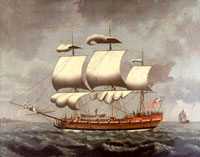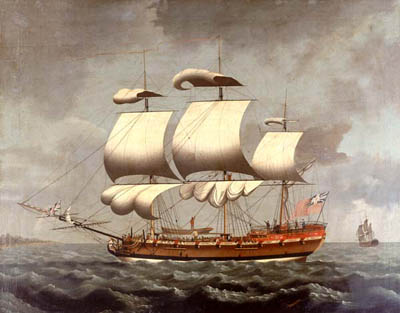
Okechukwu - On the ship
And now I am in the blackness of that huge boat. I didn't imagine that men could make such a place, not even the pale men. My head still hurts, every muscle aches from crouching in this tiny space and the metal rings on my ankles and wrists bite into my skin. I am so scared that my body rebels against everything I eat or drink.
Slave Ship

A Liverpool Slave Ship by William Jackson in 1780. We know she was a slaving ship as we can see four air holes just above the water line. The coast is probably meant to be West Africa. This 16-gun ship is shown in two views in this painting.
Boat
Okechukwu is in the part of a ship where cargo is usually kept (the hold). Before being put into the hold captives were usually stripped naked and examined from head to toe by the captain or ship's surgeon. Men and boys were then put in one space, women and younger children in another.
These spaces were even worse than the forts. The heat, stale air and sickness made just breathing unbearable. Slave ships usually had portholes which let in fresh air, but they were so close to the water line that they could only be opened in calm weather.
Body
With so much blood, vomit, stale air and excrement in such a tiny space it is no wonder that disease was common on board ship. Both crew and captives suffered from 'flux' (dysentery) and small pox. The lucky Africans were treated in the surgeon's cabin. The less fortunate ones were simply thrown overboard to protect the rest of the ship.


